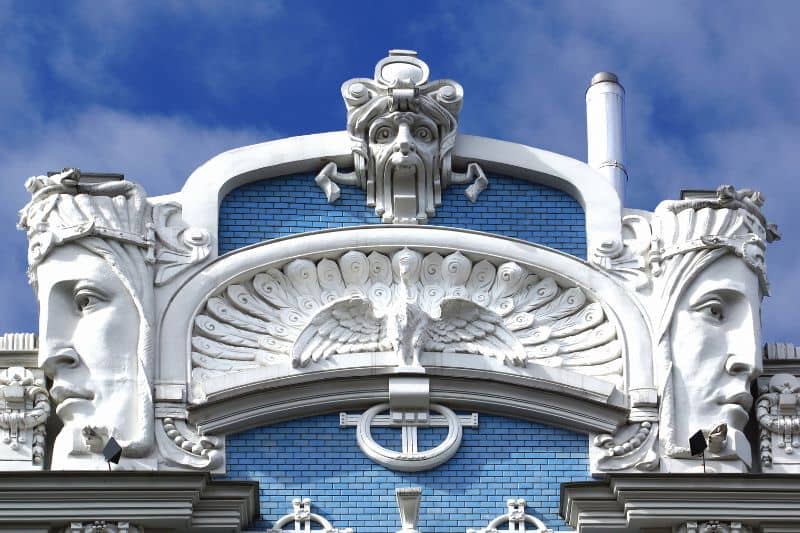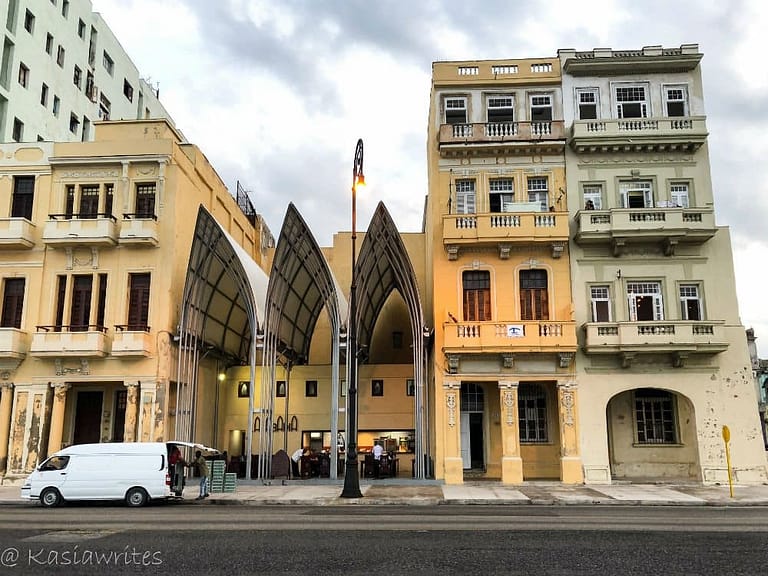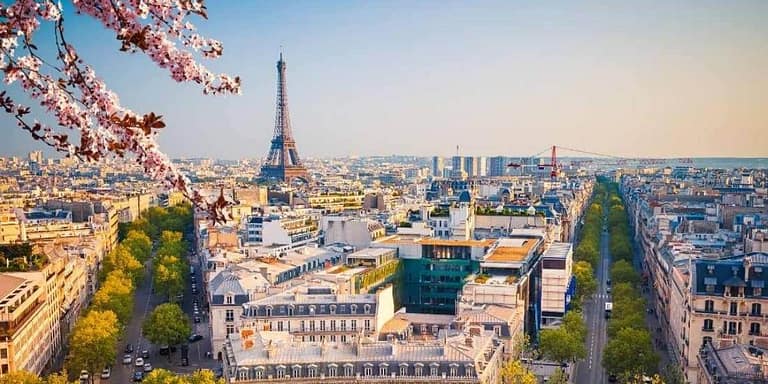Stunning Art Nouveau in Riga: Architecture Meets Fantasy
Art Nouveau architecture became all the rage at the turn of the 20th century. It swept across Europe and was quickly adopted by architects, artists and designers. While most people might think of Barcelona, Vienna or Paris as the places to see examples of Art Nouveau, the highest concentration of this architecture is actually in Riga. From stunning façades on stately old buildings to ornate doorways and whimsical balconies, Latvia’s capital is where you should go to discover an architectural treasure trove of wonders.
I didn’t know much about Riga before I went there. Then I came face to face (quite literally, but more about that later) with its architecture. It was a bit like stepping back in time, but instead of looking at a black-and-white picture, I saw it all vividly and in colour. Needless to say, it was love at first sight.
Affiliate Disclosure – This post contains affiliate links. If you make a purchase through these links, I may earn a commission. This doesn’t affect your purchases or any fees you may pay for the product or service. Read more in my DISCLAIMER.
What is Art Nouveau?
Art Nouveau is a style that emerged at the end of the 19th century and lasted until the first World War. It was a time of technological innovation that saw a transition towards a more industrialized and urban society. The world saw new manufacturing processes and major power shifts, which caused a lot of social anxiety. Art Nouveau, literally new art, was a direct response to these changes.

It evolved from the British Arts and Crafts and Aesthetic movements and was influenced by elements of Japanese art that were very popular in Europe then. The architects and artists behind this new movement wanted to create a unique style that was like nothing else before. They rejected the historicism and rigid rules of the past and looked towards nature for inspiration. Art Nouveau was also known as Jugendstil in Germany, Stile Liberty in Italy and Modernismo in Spain.
Art Nouveau style
Everything about the Art Nouveau design was about natural forms, curves and organic lines. There is a lot of symbolism, florals, botanical and abstract designs, as well as intricate patterns, earthy colours and diverse use of materials. You can also see a lot of asymmetrical compositions, rivets, arches and curved forms.
Thanks to the technological advances at the time, wrought iron, curved and stained glass were widely used in Art Nouveau designs. While there was a pull toward the natural world, there was also a fascination with the female form. Females were often incorporated into the designs as sirens or fairies. The style’s popularity extended to furniture, posters, fabrics and jewellery.
Art Nouveau vs art deco
These two styles are sometimes confused with each other as they share some similar design elements. However, there are also significant differences between the two styles. Art Nouveau is characterized by flowing, organic forms inspired by nature. Think Belle Epoque – big, handlebar moustaches, top hats, sun umbrellas and large hats. Artists like Gustav Klimt, Aubrey Beardsley and Alphonse Mucha.
Art deco, on the other hand, is more about geometric shapes and bold, streamlined designs influenced by modern technology and industrialization. It embodies opulence and embraces mass production and new materials. Think The Great Gatsby, the colourful buildings in Miami, the Chrysler building in New York City or artists like Tamara de Lempicka and Le Corbusier.


Art Nouveau architects
Several notable architects associated with this movement, whose work can still be seen all over the world. They also often worked closely with other artists and craftsmen to create design elements of buildings, like furniture, lighting and decoration, that all fit together in harmony.
- Victor Horta: Belgian designer and architect, one of the founders of the Art Nouveau movement and creator of the first house in this style – Hôtel Tassel in Brussels.
- Antoni Gaudi: The Catalan architect behind famous projects like the Sagrada Familia and Casa Batlló in Barcelona, Spain, associated with the Catalan Modernist style.
- Hector Guimard: French designer and architect considered a leader of the movement. He designed France’s first Art Nouveau apartment, the Castel Beranger, and Paris’ Metro station’s iconic iron and glass entrances.


- Charles Rennie Mackintosh: Scottish designer and architect who influenced both Art Nouveau and Secessionism movements along with his wife, Margaret MacDonald. The Glasgow School of Art is one of his most famous projects.
- Mikhail Eisenstein: Russian civil engineer and architect who worked in Riga and designed many of the Art Nouveau buildings between 1901 and 1906. It’s believed that he was influenced by the designs of Hector Guimard while he was visiting Paris and the Vienna Secession movement.
- Konstantins Pekšens: One of Latvia’s most prominent architects who designed many of Riga’s Art Nouveau buildings we see today.
Art Nouveau in Riga
During the late 19th century, Riga thrived economically and experienced rapid growth. There was also a surge of Latvian nationalism and romanticism. Art Nouveau quickly gained popularity and flourished in Riga. The wealthy and powerful used their influence to construct multi-story buildings with whimsical flourishes, striking sculptures, intricate decorations and colourful facades.

Thanks to all that building activity, Riga has the highest concentration of Art Nouveau buildings anywhere in the world. With about 800 of them, they account for one-third of all buildings in the city centre. They are an iconic symbol of Riga’s rich architectural history and a living homage to the enduring appeal of a style that took Europe by storm.
UNESCO has recognized these buildings’ incredible beauty and creativity, declaring them a part of their World Heritage Site program. This recognition highlights Riga’s efforts to preserve this spectacular Art Nouveau architecture, which has become an indispensable part of the city’s history and culture.
Exploring Art Nouveau architecture in Riga
There are many cities out there with architecture that speaks to me, yet when I came to Riga, it was on a totally different level. Sure, there are many different styles of architecture here, all with their own appeal, but it’s the Art Nouveau that really stands out.
The first thing that grabs you are the many faces that seem to rise from the facades, pillars and archways. Some are almost grotesque, with mouths gaping open almost as if in a silent scream, while others are stoic, resigned to their fate. They are like characters from some fairy tales, ones I am unfamiliar with. Some are almost fantastical, while others seem futuristic, with round helmets, rivets and almost art deco-ish geometrical shapes.




There are ornately decorated columns, floral embellishments, asymmetrical details and rounded windows. You can also spot mythical creatures, including dragons, sphynxes, gargoyles, satyrs, griffins and fairies, among the many human faces and shapes. If you look closely enough and have an active imagination, you can almost picture them coming to life and leaping off the buildings.
Then you have the sticking blue bricks contrasting with white columns, statues and bricks. Different shades of yellows, creams and pale pinks with wrought iron balconies and ornate gateways. The key here is to look up, as most of the magic happens above ground level. There are many buildings scattered throughout the city where you can admire various Art Nouveau buildings in Riga. If you don’t have a lot of time to explore, make sure to stop by Alberta and Elizabetes Streets (iela in Latvian) – you’re going to love the homes here.





Alberta Street: Alberta iela is where you can find many buildings designed by Mikhail Eisenstein with their iconic floral motifs and sky-blue facades, and stern faces peering out of the buildings. Most notable are numbers 2, 4, 6, 8 and 13. Also worth seeing is number 11, designed by Eižens Laube.
Elizabetes Street: This is another great place to find a concentration of Art Nouveau buildings in Riga. Some of the notable ones include numbers 6, 10a, 10b, 13, 21, 23 and 33. The building with the blue facade is another one of Eisenstein’s creations.
Riga’s Art Nouveau Museum: Konstantins Pekšens’ former home at Alberta street 12 is now a museum dedicated to everything Art Nouveau. The museum is a great opportunity to take a walk through the history of the style, including decor and furnishings.

Sienna Art Cafe: Head to this charming cafe for a more immersive experience. The cafe’s decor includes antique furniture, light fixtures, paintings, clocks and an old-fashioned serving station that will make you feel as if you’ve gone back in time.
Recommended tours and activities:
Final thoughts
When it comes to architecture, there are many great cities out there to explore. What makes Riga unique is that, unlike other cities, it has a high concentration of Art Nouveau buildings, which makes it easy to get a better appreciation for this style.
Riga is a vibrant city with much to offer, a testament to its long history and cultural heritage. It has been a place that has wielded a lot of influence over the years, and you can see traces of it all over the city. Art Nouveau was a big part of that history, but it’s like a layer, one of many, that make up the rich cake that is Riga. After all, who doesn’t like cake? Come and check it out yourself – you’ll be glad you did.
FAQ
Travel Resources
Planning your next trip? Check out the resources I use and start planning your perfect getaway today!
- Flights: Find the best flight deals on Kiwi.com (my new go-to for flights)
- Book your accommodations: Find the best prices on hotels with Booking.com
- What to do: Find the perfect tour with Viator
- Need a car? Book your ride with Rentalcars.com
Check out my travel resource guide for more resources to help you plan your trip.







